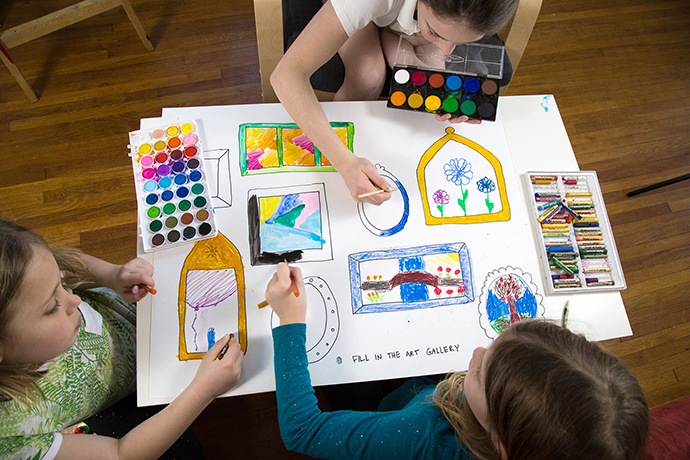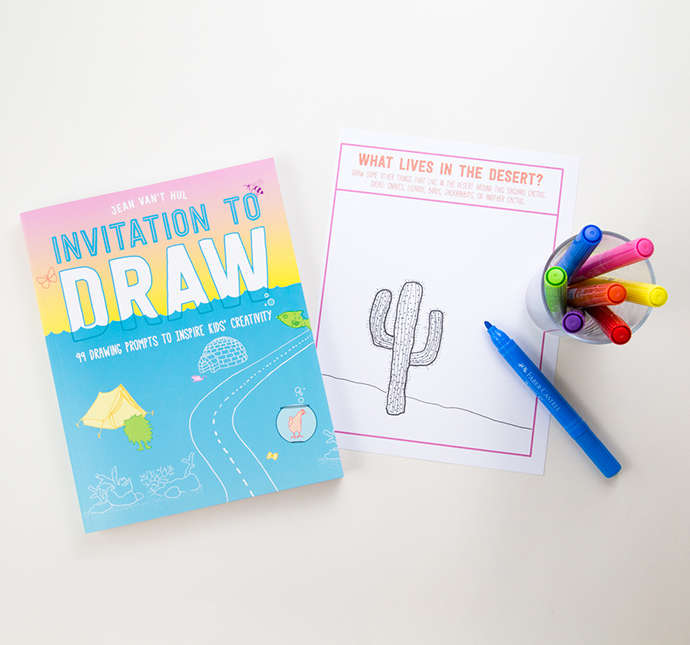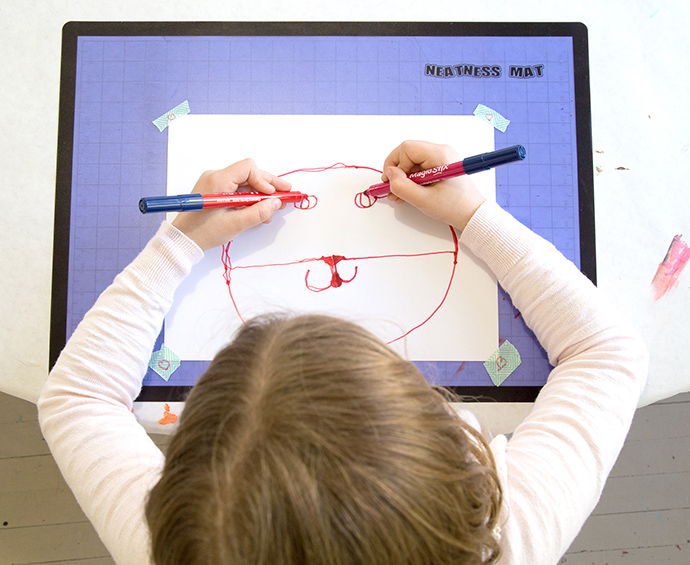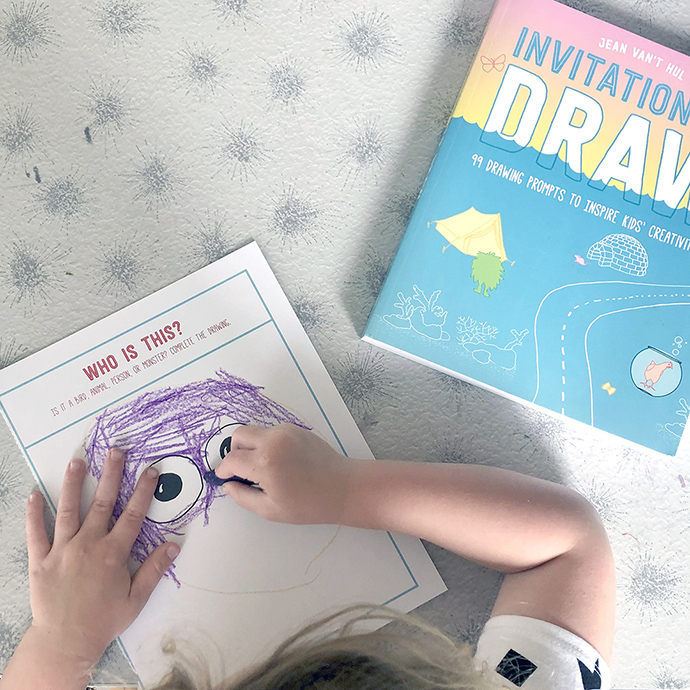
Today we are so excited to be sharing a little sneak peek into the newest book from our friend Jean Van’t Hul of The Artful Parent: Invitation to Draw! Chock full of creative drawing prompts, your kids will not be able to keep their hands off of it. Help children draw and think more creatively by inspiring them with interesting and challenging art prompts and questions!
Invitation to Draw features 99 open-ended drawing prompts, each one proposing a question to investigate that encourages children to think and problem solve. Plus, all the pages are perforated making it is so easy to tear out prompts while your family is on-the-go this summer or to allow multiple kids to draw at the same time. Genius!
Drawing prompts inspire and encourage kids to think and draw differently, and sometimes more creatively, than they might when faced with a blank page! Through the act of drawing and observing the drawing unfold, the brain continues to think and problem solve, opening up all kinds of creative possibilities around that idea.
We had a chance to chat with Jean about the new book and she shares some incredibly helpful advice for all parents. Take a look below!

Q: What inspired you to create Invitation to Draw?
JEAN: I started using simple drawing prompts with my daughters and their friends when they were quite young and I was always delighted and amazed at how much the prompts inspired
the kids!
A drawing prompt captured their imagination and attention where a blank sheet of paper might have been passed by. And the drawings that resulted were often so creative. The kids might be in a phase where they are drawing the same themes and motifs over and over (totally normal), but when presented with the simplest beginning of a drawing and possibly a question or challenge, they are inspired to draw something completely different and unique.

Q: Do you have a favorite drawing prompt from the book?
JEAN: Whatever inspires a child the most in the moment!
Sometimes it’s to create something from the imagination, such as a dream car, machine, or fantastical animal. (It’s amazing what they’ll come up with!)
Sometimes it’s a storytelling prompt that invites children to tell a story with their pictures (such as with the magic wand or the two mice with speech bubbles).
Sometimes it’s a complete-the-scene or a decorate the ______ prompt kind of drawing prompt such as the desert landscape, complete-the-animal-faces, or the decorate a cake prompt.
Sometimes it’s a simple abstract art prompt that invites kids to doodle and draw while exploring lines, shapes, and colors such as the tangle butterfly or geometric art.
Sometimes it’s a specific theme, such as anything to do with animals or wheels.

Q: Is there a unique or special place that your kids have worked on drawing prompts?
JEAN: I used to make simple drawing prompts on our large chalkboard for the kids to find. Whereas they might have passed by a blank chalkboard without pausing to draw, a drawing invitation always got their attention.
We’ve used drawing prompts in all kinds of places and situations! They are great for traveling, great for restaurants and waiting rooms, great for playdates, great for quiet-time activities when the baby is napping, great for simple art invitations.

Q: What advice do you have for parents when their kids say things like “I can’t draw”?
JEAN: Everyone can draw!
Everyone draws differently and with different styles, levels of interest, and yes, even traditional skillfulness. But everyone can draw. It’s part of being human. We make marks and give them meaning. We are highly visual creatures living in a highly visual world.
If kids say, “I can’t do math!” their parents don’t agree and remove them from 3rd grade. No! They build up their self confidence. They help them practice adding and subtracting. They look for opportunities to add more math into their lives in a fun and enticing way, perhaps by cooking a muffin recipe together and talking about the measurements while scooping up cups of flour and teaspoons of baking powder. Perhaps they pick up a couple of interesting math books, such as “How Much is a Million?” or “Bedtime Math.” And they may even enlist the help of a math tutor.
The same is true with riding a bicycle. Learning to swim. Playing an instrument. The list goes on and on. We aren’t born with those skills. We learn them over time with exposure, practice, and encouragement.
We see that kids have varying levels of confidence, interest, and natural motivation with anything and everything that they do in this life and we give them the opportunities and encouragement to develop in all areas.
Everyone can draw.
When a child says, “I can’t draw!” this is what I want to tell parents—
First, don’t take their word for it.
Secondly, acknowledge their frustration in the moment and let them know that everyone draws differently and that drawing can take practice just like baseball or handwriting, swimming or math.
I also suggest reading books on creative confidence together. The Dot and Ish, both by Peter Reynolds, are inspiring picture books on this very topic and provide good talking points.
Beautiful Oops! by Barney Saltzburg is a wonderful book about turning mistakes and accidents into something interesting and creative.
It can be helpful to investigate the vast variety of drawing styles that different artists can have, from ultra realism to pop art and abstract expressionism. Go to an art museum together (or look at images online or in books) to see some of the differences. Some artists draw a bowl of fruit so realistic that it looks like you could reach out and grab one. Other, equally respected, artists are known for drawing simplified and exaggerated images. Others draw patterns. Others seemingly scribble.
Look up Leonardo da Vinci, then look up Wassily Kandinsky. Both are incredible artists, but they have totally different drawing styles!
Others to explore include Piet Mondrian, MC Escher, Rembrandt, Paul Klee, Keith Haring, and Pablo Picasso.
I encourage parents to continue to offer a variety of opportunities to draw (drawing prompts are just one way to do this) and to make drawing fun. Play silly drawing games, draw side by side with them, or try your hand at double doodle art.
Adults can offer to help their kids improve specific drawing techniques and skills if they want it and it seems appropriate. You can do this yourself, with the help of books (Ed Emberley’s
drawing books or Mona Brookes “Drawing with Children”), or with a class.
Finally, I encourage parents to model self confidence and a willingness to try new things. Please don’t let your kids hear you say, “I can’t draw!”
Drawing is for everyone. It’s a language, like writing or music. The ability to convey an idea on paper with a sketch or design can be an important skill in almost any endeavor or field. Visual skills are not just for artists. They are for engineers, teachers, environmental designers, contractors, inventors, and more.
Plus, drawing is fun! Enjoy it!

Thank you so much to Jean for sharing these incredibly valuable insights with us! Make sure to pick up your copy of Invitation to Draw today.